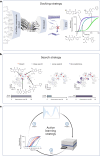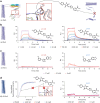Discovery of potent inhibitors of α-synuclein aggregation using structure-based iterative learning
- PMID: 38632492
- PMCID: PMC11062903
- DOI: 10.1038/s41589-024-01580-x
Discovery of potent inhibitors of α-synuclein aggregation using structure-based iterative learning
Abstract
Machine learning methods hold the promise to reduce the costs and the failure rates of conventional drug discovery pipelines. This issue is especially pressing for neurodegenerative diseases, where the development of disease-modifying drugs has been particularly challenging. To address this problem, we describe here a machine learning approach to identify small molecule inhibitors of α-synuclein aggregation, a process implicated in Parkinson's disease and other synucleinopathies. Because the proliferation of α-synuclein aggregates takes place through autocatalytic secondary nucleation, we aim to identify compounds that bind the catalytic sites on the surface of the aggregates. To achieve this goal, we use structure-based machine learning in an iterative manner to first identify and then progressively optimize secondary nucleation inhibitors. Our results demonstrate that this approach leads to the facile identification of compounds two orders of magnitude more potent than previously reported ones.
© 2024. The Author(s).
Conflict of interest statement
R.I.H., M.N., S.C. and P.S. have been consultants of WaveBreak Therapeutics (formerly Wren Therapeutics). R.S. and A.P. have been employees of WaveBreak Therapeutics. M.V. and T.P.J.K. are founders of WaveBreak Therapeutics. WaveBreak Therapeutics is a company that seeks to identify therapeutics for neurodegeneration. The other authors declare no competing interests.
Figures






Similar articles
-
Structure-Based Discovery of Small-Molecule Inhibitors of the Autocatalytic Proliferation of α-Synuclein Aggregates.Mol Pharm. 2023 Jan 2;20(1):183-193. doi: 10.1021/acs.molpharmaceut.2c00548. Epub 2022 Nov 14. Mol Pharm. 2023. PMID: 36374974 Free PMC article.
-
A Fragment-Based Method of Creating Small-Molecule Libraries to Target the Aggregation of Intrinsically Disordered Proteins.ACS Comb Sci. 2016 Mar 14;18(3):144-53. doi: 10.1021/acscombsci.5b00129. Epub 2016 Feb 29. ACS Comb Sci. 2016. PMID: 26923286
-
Exploration and Exploitation Approaches Based on Generative Machine Learning to Identify Potent Small Molecule Inhibitors of α-Synuclein Secondary Nucleation.J Chem Theory Comput. 2023 Jul 25;19(14):4701-4710. doi: 10.1021/acs.jctc.2c01303. Epub 2023 Mar 20. J Chem Theory Comput. 2023. PMID: 36939645 Free PMC article.
-
α-Synuclein aggregation modulation: an emerging approach for the treatment of Parkinson's disease.Future Med Chem. 2017 Jun;9(10):1039-1053. doi: 10.4155/fmc-2017-0016. Epub 2017 Jun 20. Future Med Chem. 2017. PMID: 28632413 Free PMC article. Review.
-
Toward the discovery and development of effective modulators of α-synuclein amyloid aggregation.Eur J Med Chem. 2019 Apr 1;167:10-36. doi: 10.1016/j.ejmech.2019.01.045. Epub 2019 Jan 28. Eur J Med Chem. 2019. PMID: 30743095 Review.
Cited by
-
A Focus on the Link Between Metal Dyshomeostasis, Norepinephrine, and Protein Aggregation.Antioxidants (Basel). 2025 Mar 15;14(3):347. doi: 10.3390/antiox14030347. Antioxidants (Basel). 2025. PMID: 40227404 Free PMC article. Review.
-
Repurposing major metabolites of lamiaceae family as potential inhibitors of α-synuclein aggregation to alleviate neurodegenerative diseases: an in silico approach.Front Pharmacol. 2025 Apr 16;16:1519145. doi: 10.3389/fphar.2025.1519145. eCollection 2025. Front Pharmacol. 2025. PMID: 40308772 Free PMC article.
-
Multiplexed Digital Characterization of Misfolded Protein Oligomers via Solid-State Nanopores.J Am Chem Soc. 2023 Nov 29;145(47):25776-25788. doi: 10.1021/jacs.3c09335. Epub 2023 Nov 16. J Am Chem Soc. 2023. PMID: 37972287 Free PMC article.
-
Substrate-based discovery of α-hydroxycarboxylic acid derivatives as potential herbicides targeting dihydroxyacid dehydratase.Nat Commun. 2025 Jun 4;16(1):5205. doi: 10.1038/s41467-025-60489-8. Nat Commun. 2025. PMID: 40467578 Free PMC article.
-
Detection of protein oligomers with nanopores.Nat Rev Chem. 2025 Apr;9(4):224-240. doi: 10.1038/s41570-025-00694-7. Epub 2025 Mar 5. Nat Rev Chem. 2025. PMID: 40045069 Review.
References
-
- Aarsland D, et al. Parkinson disease-associated cognitive impairment. Nat. Rev. Dis. Prim. 2021;7:47. - PubMed
-
- Balestrino R, Schapira AHV. Parkinson disease. Eur. J. Neurol. 2020;27:27–42. - PubMed
-
- Poewe W. Parkinson disease Primer—a true team effort. Nat. Rev. Dis. Prim. 2020;6:31. - PubMed
-
- Savica R, Boeve BF, Mielke MM. When do alpha-synucleinopathies start? An epidemiological timeline: a review. JAMA Neurol. 2018;75:503–509. - PubMed
Publication types
MeSH terms
Substances
Grants and funding
LinkOut - more resources
Full Text Sources
Research Materials

